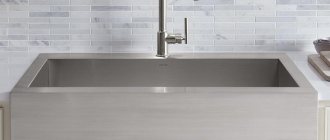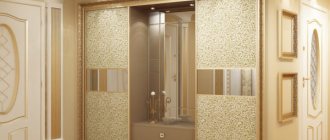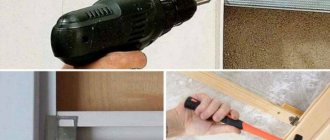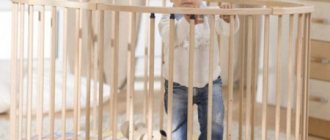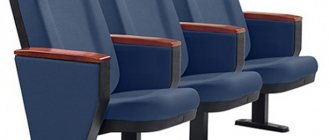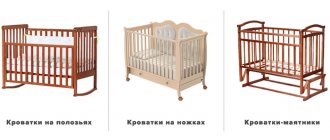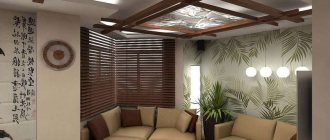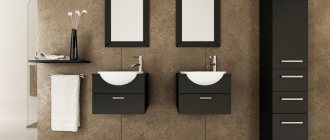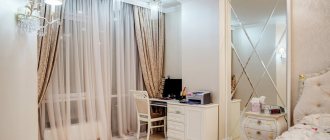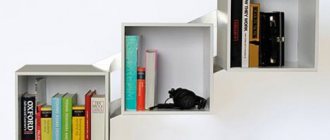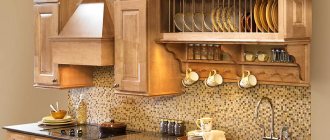Classification of rods
The crossbar performs the following functions in the interior:
- Aesthetic. It is a kind of decoration for the bathroom.
- Curtain fastening.
Depending on the configuration, the following types of frames are distinguished:
- With a rectangular cross-section. This is a traditional design, common back in Soviet times.
- Corner holder for curtains in the bathroom. Great for corner bathtubs. The cornice has the shape of an arc or semicircle.
- Holder for plumbing fixtures of complex shape.
Important! The crossbar can be attached to the walls or ceiling. In the latter case, decorative reflectors are used to disguise the fastenings. Holders with a telescopic (folding) rod are very functional. They can be used for any premises.
The following materials can be used as manufacturing materials:
- Chromed steel.
- Aluminium alloy.
- Plastic.
Important! Plastic and aluminum are inferior in strength to steel. But steel products are more expensive.
The procedure for installing a straight cornice
Plastic and steel bathroom curtain rods are made from pipes with a diameter of up to 25 mm. They are attached to the walls in a spacer, but in this case they lose the ability to withstand heavy curtains or wet towels and things. Typically, brackets are used to attach the cornice, secured with self-cut screws. The brackets are covered with decorative overlays. The components of metal structures are made of stainless steel or aluminum, so they are not susceptible to corrosion.
To properly secure a straight cornice, you need to attach it to the bathtub and move the decorative trims to the center. Use a pencil to mark the points where the rod meets the wall. To do this, you will have to measure the height of the structure above the bathtub, which is determined by the size of the curtain.
Attention! Usually it is 1.8 - 2 m, the main thing is that its lower edge is located 0.2 m below the bath, as this will prevent splashing.
Subtract 0.2 m from the height of the curtain and measure this distance upward from the bathtub. This operation must be done on each side in order to calculate the center of the bracket placement. Fasteners are applied to the marked points so that their center exactly coincides with the mark made.
Mark the locations for the dowel holes through the holes in the fasteners. Then 45 cm recesses are drilled into the wall, into which plastic dowels are inserted. It is necessary that 0.5 mm of the dowel protrudes from the hole to comply with the technological process for attaching the cornice.
The rod is put on the fastener glass, and then the structure is fixed with screws to the surface of the walls. The final touch will be the movement of decorative reflectors to the walls, covering the brackets.
Types of fasteners
Let's take a closer look at the main types of fastenings for curtains in the bathroom.
Hooks
This is the most inexpensive choice, but it also has a significant drawback - a limited area of use. Hooks are best suited for flat and rectangular crossbars. They perfectly hold curtains made of various materials.
Important! To prevent the hooks from sliding off the cornice, stops must be placed on both sides of the cornice.
Rings
Rings have rightfully occupied a significant place in bathroom design. They look very good. In addition, you can find rings of different colors and different materials on sale.
Important! They also have a drawback - you can only put the ring on the cornice during installation.
Eyelets
Another type of fastener, which consists of holes in the curtain fabric, secured with metal. Eyelets are one of the most expensive types of fastening curtains in the bathroom, but the curtain itself looks very beautiful. Sliding along the bar also occurs without problems.
Important! Eyelets can be used for different types of textiles, except those that are too thin and light.
Loops
Some curtain models are sold with loops. If you wish, you can order them from a studio or sew them yourself. These fasteners are suitable for rods of any shape. But good glide can only be ensured on a smooth, polished surface.
Clamps
Decorative crab clips make it possible to adjust the length of curtains. Their cost is low, and they look very decorative. The ideal option for hanging on clips is not too thick textiles. Heavy curtains are unlikely to stay on them.
Important! For families with small children this is not the best option.
String
If for some reason it is not possible to install a cornice, you can mount special brackets with a metal string stretched between them. The string is ideally suited for thin and light textiles and looks very elegant.
Types of products
The selection of cornices should be carried out taking into account certain features of the room . The products have ceiling or wall mounting, as well as different fixing options. Some of them can be installed personally by the owners, however, it is worth first understanding the types of rods and the nuances of their use.
There are such common forms of cornices:
- L-shaped curtain rod for the bathroom (mounted to the walls and has a bend angle of 90 degrees). With the help of such a curved cornice, it is possible to limit the space for a regular bathtub in the shape of a rectangle or triangle. In addition to fasteners, such products can be accompanied by various decorative elements.
- U-shaped (installed on one wall of the room and used mainly for square bathtubs). Often, such cornices are made to order and require additional fixing elements for fastening to the ceiling.
- The radial configuration of products can be installed along the edges of asymmetrical or rounded bathtubs with the same contours. People buy these curtain rods because of their elegance and ability to highlight the space of a room.
Corner curtain rods for bathrooms can be made of different materials, which affects their cost. By choosing one option or another, the future owner will be able to ensure convenience and long-term operation. Thus, holders for curtains or shower curtains in the bathroom can be made from the following materials:
- Plastic allows you to silently open and close curtains, but polymer metal masses are stronger and more durable.
- Aluminum and steel. The first ones can be found in bathrooms most often, since they are not damaged by corrosion and temperature changes, but due to their lightness, the weight of the curtains when wet leads to sagging of the structures. When choosing a stainless steel cornice, you can create a rod of any shape, as well as achieve maximum service life.
- Combined products combine the advantages of polymer and metal analogues, and also do not make noise when used.
Video material
Before giving preference to one or another type of fasteners, you must first weigh all the pros and cons, evaluate the advantages and disadvantages of each possible type. Eyelets look beautiful, but their price is high. If the bar cannot be installed, then installing metal strings would be a good solution. Special corner fasteners are sold for curtains on corner bathtubs and cabins. Now let’s get to work adding the finishing touches to the bathroom design!
Curtain holder in the bathroom
Even such a seemingly insignificant bathroom accessory, such as a curtain that acts as a splash guard, can significantly change the entire interior composition of your bathroom. Therefore, when choosing curtains and curtain rods, it is extremely necessary to remember both the functional and aesthetic aspects of the issue.
The main criteria when selecting a cornice are the strength and reliability of its design, as well as a presentable appearance that will not stand out from the overall design solution of the bathroom.
Types of cornices
Today, there are the following types of cornices:
- Straight. Such a cornice can be installed on the walls using metal disks (flanges).
- Angular. The L-shaped cornice, which has one rectangular corner in its design, also today there are more intricate U-shaped rods.
- Telescopic. This is a transforming cornice, the length of which can be varied depending on your needs.
- Spring-loaded. This design secures the curtain with a strong metal spring.
- Flexible. A universal curtain rod that is suitable for baths of any shape and size.
- Non-standard. Cornice made to order.
All models are also characterized by certain features of their fixation process. Sometimes, to enhance the strength of the structure, it is necessary to install additional clamps on the ceiling.
A stylish cornice can be a wonderful accessory for your bathroom
Material for cornice
By choosing a durable, wear-resistant material for the cornice, you can significantly improve the quality of its use, as well as extend its service life. It is clear that a metal structure will last much longer than a plastic rod, since metal is less susceptible to cracks and breaks. Also important is the issue of maintenance, for example, plastic acquires an unpleasant yellowish coating over time, which is almost impossible to remove without damaging the entire structure.
Almost the only advantage of a plastic rod is its low cost, which allows you to almost painlessly replace a worn cornice with a new model.
As a rule, stainless steel or aluminum is used to make a metal rod. The advantage of aluminum is its flexibility, which allows you to give the desired shape to your cornice without much difficulty.
After processing, metal becomes a fairly durable material, easy to clean, does not rust or deteriorate. If the design of your bathroom requires a more non-standard approach to solving the issue of selecting and installing a cornice, you can order a model from almost any necessary metal.
Durable metal construction will serve you well for a long time
Installation of curtain rods
Having decided on the choice of the necessary accessory, the question arises of how to hang the curtain in the bathroom as securely as possible. As a rule, the installation process does not depend on the model you choose and does not differ significantly. Special metal flanges fixed to the walls make it easy to install the entire structure. However, there are some nuances that slightly distinguish the installation process of a particular model.
There are only two types of cornice installation:
Only when installing corner rods will they require additional ceiling fixation. When choosing and installing a rod, pay attention to the covering of your ceilings; ceiling mounting will become impossible if you have a suspended ceiling in your bathroom.
Installation of telescopic cornice
The practicality of the prefabricated telescopic structure lies in the versatility of its size. Its installation is quite simple, all you need is to decide on the required height and length and simply fix the bar.
This cornice is simply inserted between the walls. The spring inside the cornice will tightly fix it at the required height. As a rule, such a design turns out to be somewhat troublesome in practice, since it periodically moves or even falls. Considering these flaws in its functioning, you should not install such a cornice if there are children in the house in order to avoid injury to them.
Mounting with fasteners
Installing a wall or ceiling structure will require much more effort, during which you will have to use a drill or drill, a level, a screwdriver and a marking pencil.
Installation takes place in several stages:
- Mark the places where the rod will be fixed on the walls, having first tried on the structure.
- Using a level, move your marks about 1.5 m higher, depending on the length of the screen you need. Do not fix the rod to the tile joint; this may cause deformation of the tile finish.
- Drill 4-5 cm holes to secure the dowel.
- Install and secure the ends of the rod with screws.
- Insert the cornice into the fasteners and secure them with decorative attachments.
High-quality installation will make it impossible for the cornice to break
When is it necessary to install a corner curtain?
Of course, installing a curtain is not a mandatory stage of bathroom equipment, however, there are situations when you cannot do without it. First of all, this:
- if the shower head bracket is located high and especially when it is located on the wall running along the longitudinal side of the bath;
- if you plan to install a hydrobox;
- if you purchased a shower head with a cascade spout, such as “waterfall effect” or “tropical rain”.
In such cases, installing a curtain is a necessity, since otherwise, after each shower, the floor will probably be flooded with water. Moreover, if with a high installation of the shower bracket, you can hang a soft corner curtain, then when building a hydrobox or using a cascade shower head, you need to use the option with hard ones - glass or plastic.
So, the curtain installed for corner baths simultaneously performs two important functions. Firstly, it protects the floor from splashes, and secondly, it carries a decorative load.
If special equipment is used (cascade shower heads, hydromassage units, etc.), it is recommended to give preference to rigid curtains made of glass or plastic installed on the side of the bathtub.
These curtains have different designs, so you can choose the right option for any bath. If the bathtub and shower are used carefully, you can limit yourself to hanging it on a special holder made of vinyl or polyester.
